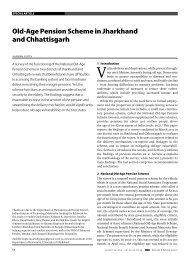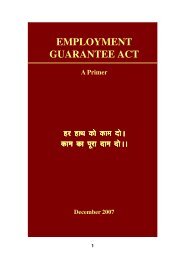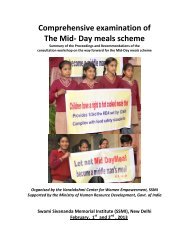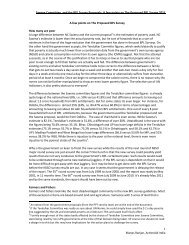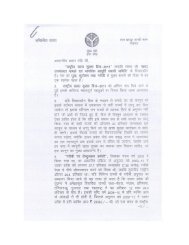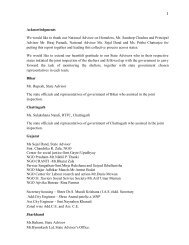NREGA: Opportunities and Challenges - Diksha
NREGA: Opportunities and Challenges - Diksha
NREGA: Opportunities and Challenges - Diksha
Create successful ePaper yourself
Turn your PDF publications into a flip-book with our unique Google optimized e-Paper software.
<strong>NREGA</strong>: OPPORTUNITIES AND CHALLENGESARGENTINA’S EMPLOYMENT GUARANTEE SCHEMEArgentina’s employment guarantee scheme known as Plan Jefes de Hogar makes an interesting study on the role ofinstitutional framework for success of public wage programme. After the country’s economy collapsed in early 1990sleading to large-scale unemployment, the government started the Jefes programme to give employment to heads ofhouseholds through a presidential decree in January 2002. Later it became a law. Most of the other employment generationprogrammes <strong>and</strong> safety net schemes were transferred to the Jefes scheme. The programme pays 150 pesos per month to ahead of household for a minimum of 4 hours of work daily. Participants work in community services <strong>and</strong> small construction,agricultural, or maintenance activities, or are directed to training programmes. The household must contain children underage 18, persons with physical disabilities or a pregnant woman.One of the most distinguishing features of the program’s institutional design is its decentralised model ofadministration. The Argentina federal government provides the funding for salaries as well as a portion of equipment costs,general guidelines for the execution of work projects, <strong>and</strong> some auxiliary services for managing the program. The municipalgovernments primarily execute the actual administration of the program. The municipalities are responsible for assessingthe pressing needs <strong>and</strong> available resources of their communities <strong>and</strong> for evaluating the projects proposed by the local nonprofitsor NGOs. A large majority of the projects are designed specifically to cater to community needs by directly providinggoods <strong>and</strong> services. According to labour ministry data, 87 per cent of Jefes beneficiaries work in community projects. Theseinclude primary agricultural micro-enterprises <strong>and</strong> various social <strong>and</strong> community services. Improving sewer system <strong>and</strong>water drainage are two prime activities.(Sources: Employment Analysis <strong>and</strong> Research Unit, International Labour Office, Geneva, August 2007)●Any other work, which may be notified by the Central government in consultation with the stategovernmentOld letters, new spirits<strong>NREGA</strong> practically follows the format of the Employment Assurance Scheme (EAS) <strong>and</strong> the National Foodfor Work Programme (NFFWP). These two programmes worked on the same principle of using labour tocreate productive assets. <strong>NREGA</strong> follows the guidelines of the National Food For Work Programme, whichwas launched in November 2004 in 150 of the poorest districts of the country (Read a background paperon <strong>NREGA</strong> http://cseindia.org/programme/nrml/nrml-index.htm <strong>and</strong> See box: Rural wage employmentprogrammes in India). All districts under the NFFWP have been subsumed under the <strong>NREGA</strong> now. NFFWPguidelines focus on water conservation works, <strong>and</strong> the only addition in the Act is irrigation canals <strong>and</strong>micro- <strong>and</strong> minor irrigation. According to the guidelines, an expert agency will be hired for formulatingvillage, intermediate <strong>and</strong> district plans. Panchayat representatives, local members of legislative assembly<strong>and</strong> members of parliament will be consulted by this agency in preparing the plans <strong>and</strong> the shelf ofprojects. The works recommended by gram panchayats will get priority over other works.Under the Act each state is required to formulate a Rural Employment Guarantee Scheme within six monthsof its enactment. Broad features of the Act like preferred works are non-negotiable thus no state canchange it under its state scheme. Till the time the state has not formulated the scheme <strong>and</strong> its guidelines,the annual or perspective plan under the NFFWP will work as action plan for <strong>NREGA</strong> implementation.The state government formulates regulations to facilitate the overall implementation. It sets up the StateEmployment Guarantee Council to advise the government on implementation of the scheme, <strong>and</strong> toevaluate <strong>and</strong> monitor it. The council also takes decisions on the preferred works to be undertaken in thestate. The central government’s rural development ministry is the nodal ministry for implementation <strong>and</strong>fund disbursal. It also monitors <strong>and</strong> evaluates the scheme. Further it sets up the Central EmploymentGuarantee Council for advising it on various issues related to <strong>NREGA</strong>.Broadly, the village <strong>and</strong> intermediary panchayats manage the implementation activities while coordinationactivities are done at the district panchayat level. Planning, supervision <strong>and</strong> monitoring take place at alllevels. However, at every level the agencies concerned are accountable to the communities.11



